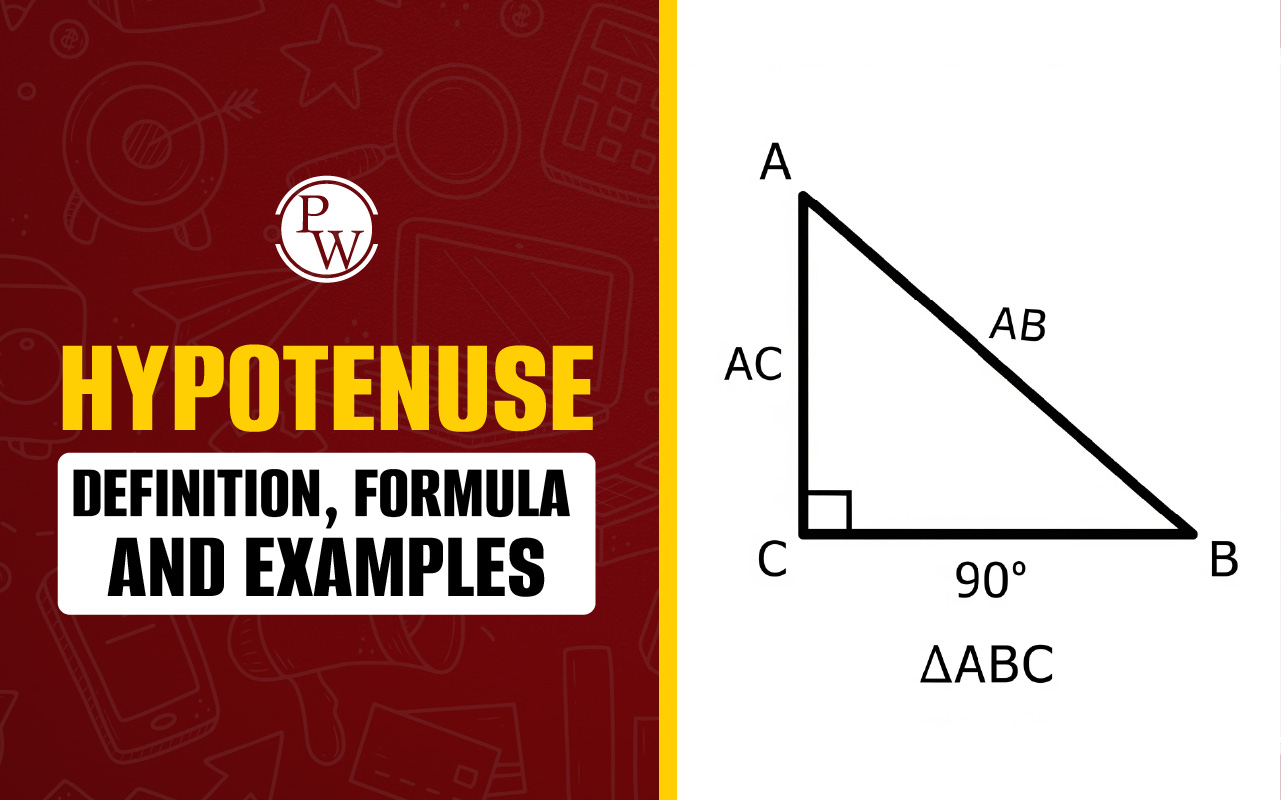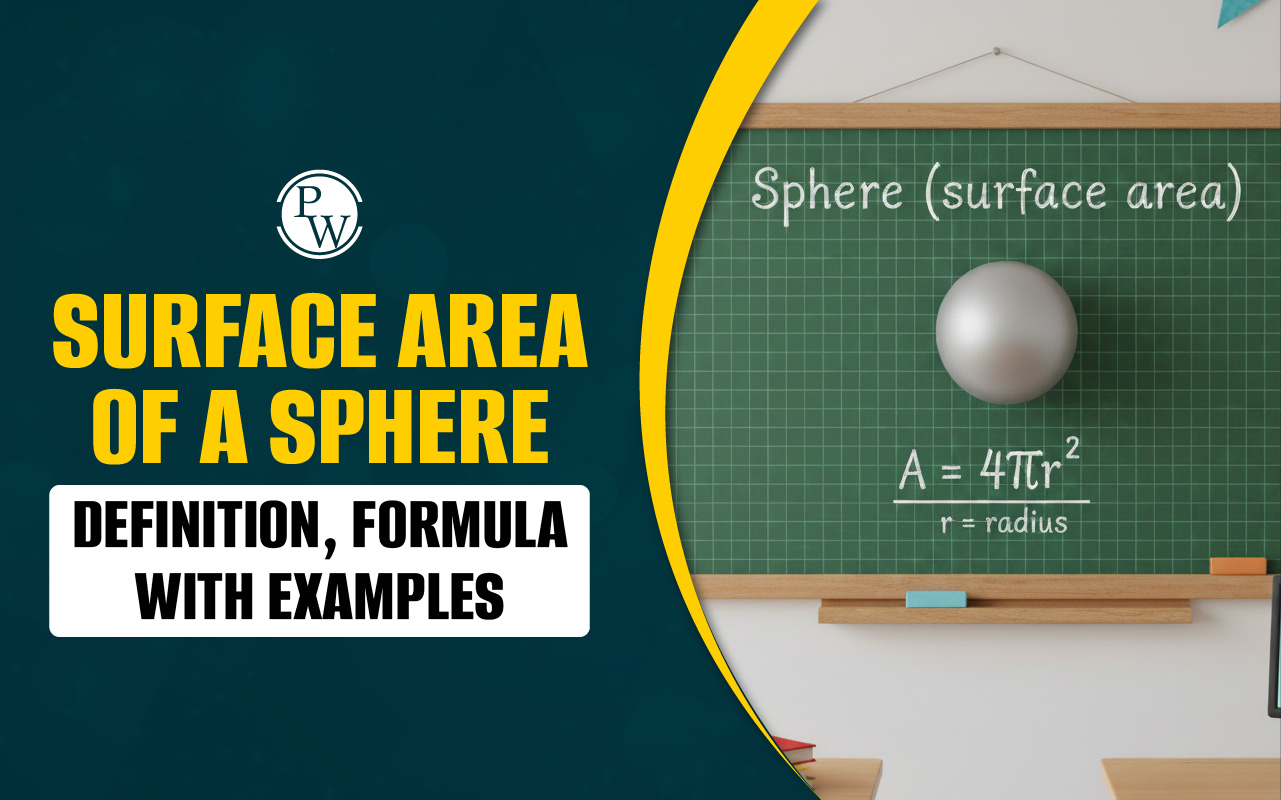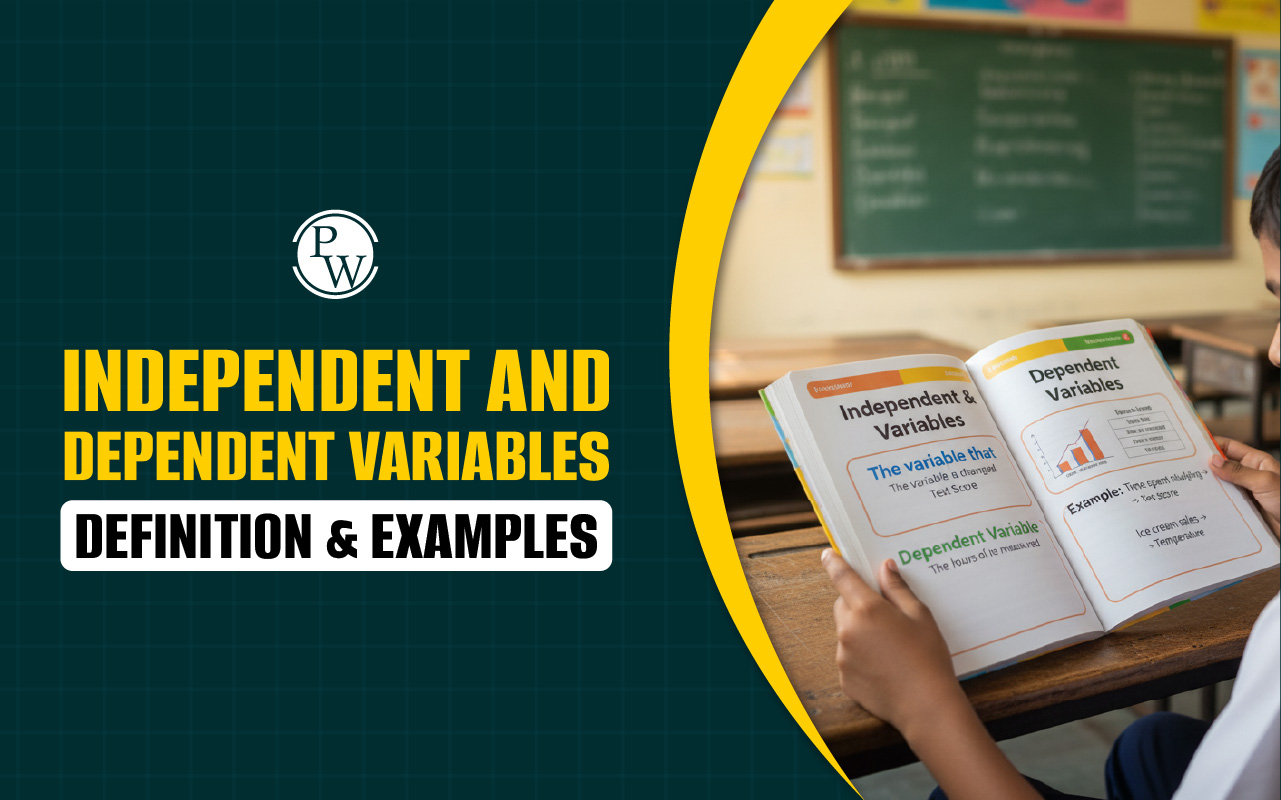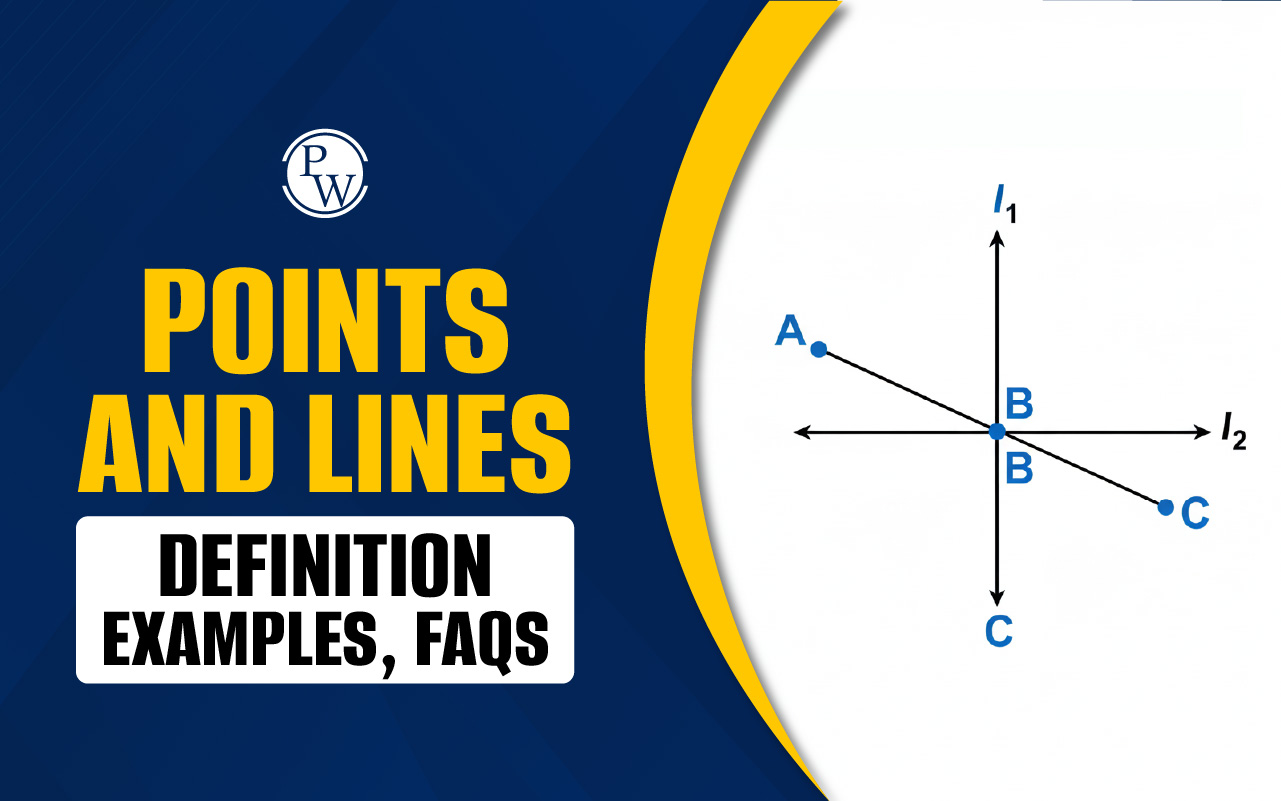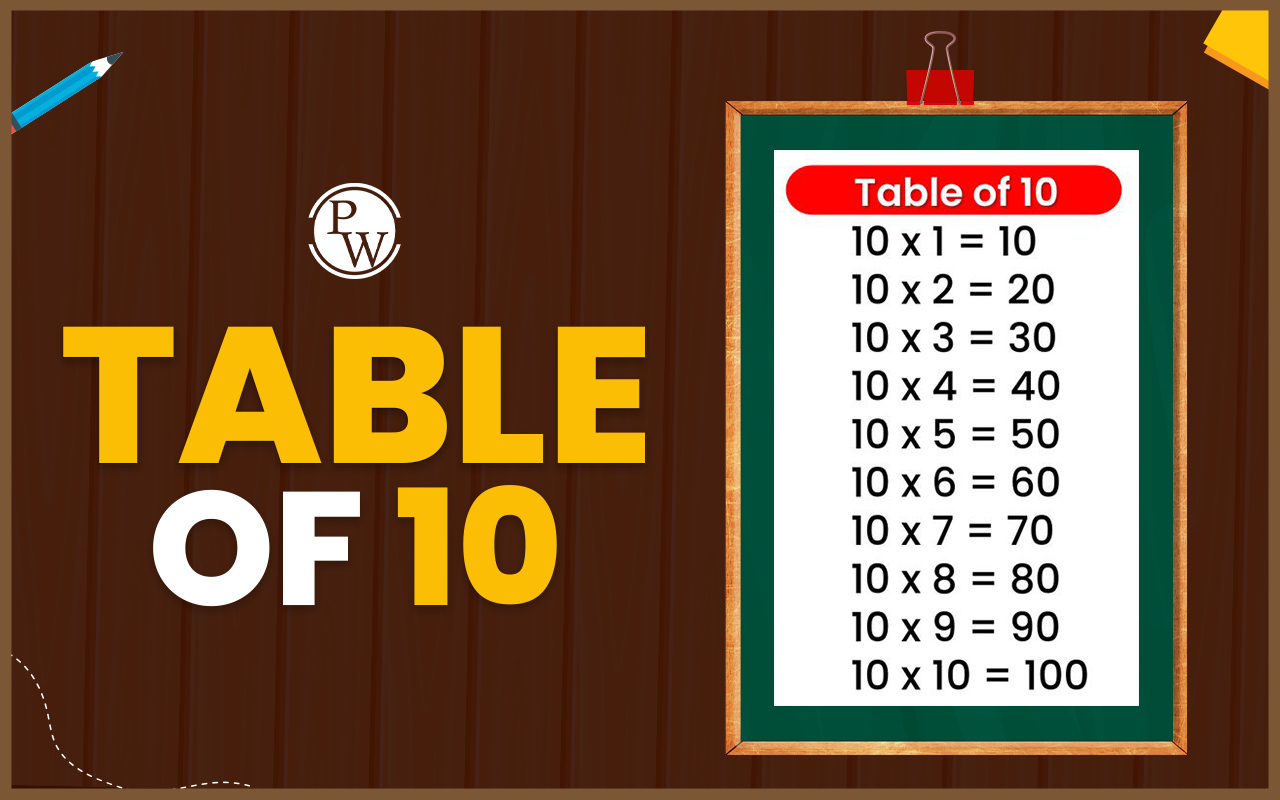
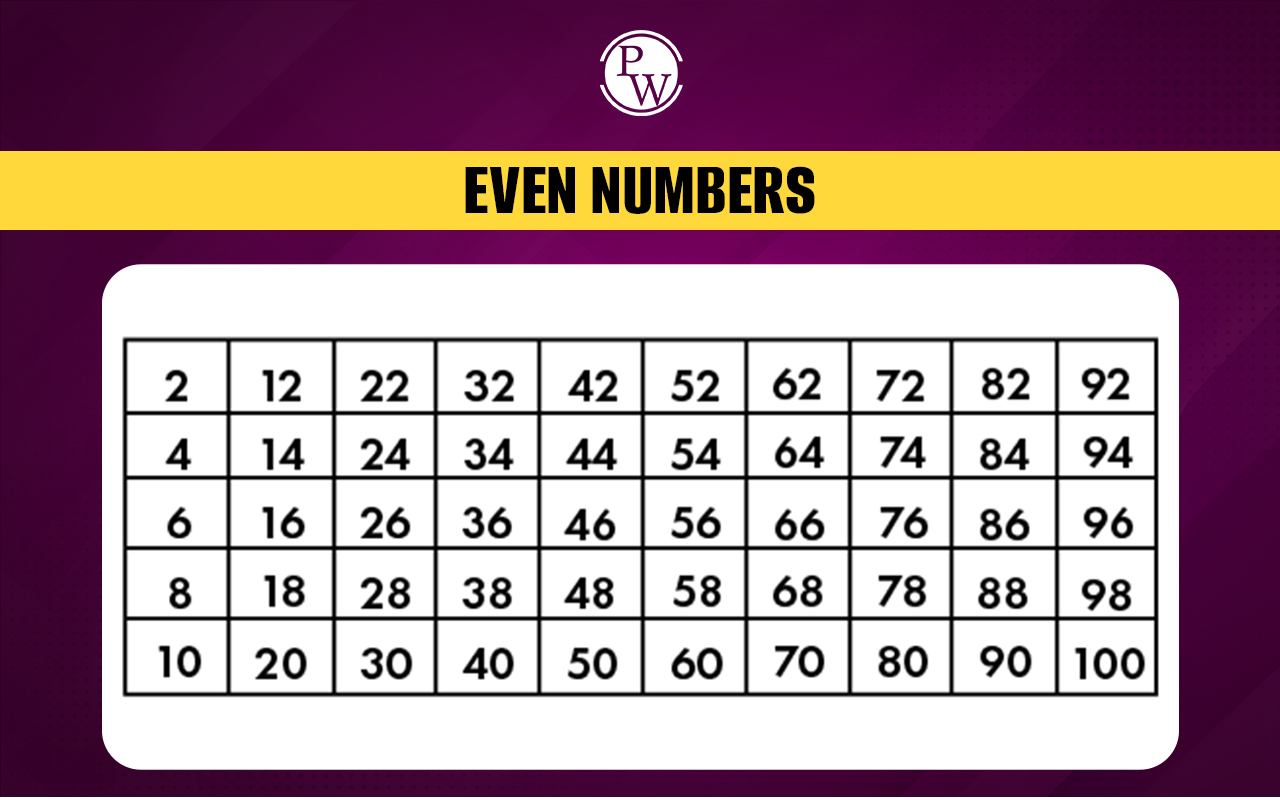
Even Numbers: Even numbers are whole numbers that can be divided by 2 without leaving any remainder. They play a key role in mathematics and are essential for learning basic arithmetic. Some examples of even numbers include 2, 4, 6, 8, and 10.
These numbers have interesting properties, such as always being the sum of two consecutive odd numbers. When you multiply two even numbers, the result is always an even number.
Even numbers are helpful in understanding how numbers work together in various mathematical situations. They are one of the fundamental building blocks of math. Study notes on even numbers, their definition, list 1 to 1000, properties, and more are provided below.
Even Numbers Definition
Even numbers are whole numbers that can be divided by 2 without leaving a remainder. Examples of even numbers include 2, 4, 6, 8, and 10. These numbers are important in mathematics and are often used in different calculations and number patterns. Even numbers help us understand basic math concepts and solve problems more easily.
Even Numbers Example
Question : If you have 14 pencils and want to give them equally to 2 students, how many pencils will each student receive? Answer : Each student will receive 7 pencils, and the total number of pencils is 14. Since 14 can be divided by 2 without a remainder, 14 is an even number.
Even Numbers 1 to 1000
Even numbers are whole numbers that are divisible by 2 without leaving a remainder. These numbers appear frequently in different mathematical situations. Below is a table of even numbers from 1 to 1000, arranged in rows for easy reference:
| Even Numbers 1 to 1000 | |||||||||
| 2 | 4 | 6 | 8 | 10 | 12 | 14 | 16 | 18 | 20 |
| 22 | 24 | 26 | 28 | 30 | 32 | 34 | 36 | 38 | 40 |
| 42 | 44 | 46 | 48 | 50 | 52 | 54 | 56 | 58 | 60 |
| 62 | 64 | 66 | 68 | 70 | 72 | 74 | 76 | 78 | 80 |
| 82 | 84 | 86 | 88 | 90 | 92 | 94 | 96 | 98 | 100 |
| 102 | 104 | 106 | 108 | 110 | 112 | 114 | 116 | 118 | 120 |
| 122 | 124 | 126 | 128 | 130 | 132 | 134 | 136 | 138 | 140 |
| 142 | 144 | 146 | 148 | 150 | 152 | 154 | 156 | 158 | 160 |
| 162 | 164 | 166 | 168 | 170 | 172 | 174 | 176 | 178 | 180 |
| 182 | 184 | 186 | 188 | 190 | 192 | 194 | 196 | 198 | 200 |
| 202 | 204 | 206 | 208 | 210 | 212 | 214 | 216 | 218 | 220 |
| 222 | 224 | 226 | 228 | 230 | 232 | 234 | 236 | 238 | 240 |
| 242 | 244 | 246 | 248 | 250 | 252 | 254 | 256 | 258 | 260 |
| 262 | 264 | 266 | 268 | 270 | 272 | 274 | 276 | 278 | 280 |
| 282 | 284 | 286 | 288 | 290 | 292 | 294 | 296 | 298 | 300 |
| 302 | 304 | 306 | 308 | 310 | 312 | 314 | 316 | 318 | 320 |
| 322 | 324 | 326 | 328 | 330 | 332 | 334 | 336 | 338 | 340 |
| 342 | 344 | 346 | 348 | 350 | 352 | 354 | 356 | 358 | 360 |
| 362 | 364 | 366 | 368 | 370 | 372 | 374 | 376 | 378 | 380 |
| 382 | 384 | 386 | 388 | 390 | 392 | 394 | 396 | 398 | 400 |
| 402 | 404 | 406 | 408 | 410 | 412 | 414 | 416 | 418 | 420 |
| 422 | 424 | 426 | 428 | 430 | 432 | 434 | 436 | 438 | 440 |
| 442 | 444 | 446 | 448 | 450 | 452 | 454 | 456 | 458 | 460 |
| 462 | 464 | 466 | 468 | 470 | 472 | 474 | 476 | 478 | 480 |
| 482 | 484 | 486 | 488 | 490 | 492 | 494 | 496 | 498 | 500 |
| 502 | 504 | 506 | 508 | 510 | 512 | 514 | 516 | 518 | 520 |
| 522 | 524 | 526 | 528 | 530 | 532 | 534 | 536 | 538 | 540 |
| 542 | 544 | 546 | 548 | 550 | 552 | 554 | 556 | 558 | 560 |
| 562 | 564 | 566 | 568 | 570 | 572 | 574 | 576 | 578 | 580 |
| 582 | 584 | 586 | 588 | 590 | 592 | 594 | 596 | 598 | 600 |
| 602 | 604 | 606 | 608 | 610 | 612 | 614 | 616 | 618 | 620 |
| 622 | 624 | 626 | 628 | 630 | 632 | 634 | 636 | 638 | 640 |
| 642 | 644 | 646 | 648 | 650 | 652 | 654 | 656 | 658 | 660 |
| 662 | 664 | 666 | 668 | 670 | 672 | 674 | 676 | 678 | 680 |
| 682 | 684 | 686 | 688 | 690 | 692 | 694 | 696 | 698 | 700 |
| 702 | 704 | 706 | 708 | 710 | 712 | 714 | 716 | 718 | 720 |
| 722 | 724 | 726 | 728 | 730 | 732 | 734 | 736 | 738 | 740 |
| 742 | 744 | 746 | 748 | 750 | 752 | 754 | 756 | 758 | 760 |
| 762 | 764 | 766 | 768 | 770 | 772 | 774 | 776 | 778 | 780 |
| 782 | 784 | 786 | 788 | 790 | 792 | 794 | 796 | 798 | 800 |
| 802 | 804 | 806 | 808 | 810 | 812 | 814 | 816 | 818 | 820 |
| 822 | 824 | 826 | 828 | 830 | 832 | 834 | 836 | 838 | 840 |
| 842 | 844 | 846 | 848 | 850 | 852 | 854 | 856 | 858 | 860 |
| 862 | 864 | 866 | 868 | 870 | 872 | 874 | 876 | 878 | 880 |
| 882 | 884 | 886 | 888 | 890 | 892 | 894 | 896 | 898 | 900 |
| 902 | 904 | 906 | 908 | 910 | 912 | 914 | 916 | 918 | 920 |
| 922 | 924 | 926 | 928 | 930 | 932 | 934 | 936 | 938 | 940 |
| 942 | 944 | 946 | 948 | 950 | 952 | 954 | 956 | 958 | 960 |
| 962 | 964 | 966 | 968 | 970 | 972 | 974 | 976 | 978 | 980 |
| 982 | 984 | 986 | 988 | 990 | 992 | 994 | 996 | 998 | 1000 |
Properties of Even Numbers
Even numbers possess distinct properties that make them crucial in mathematics. Understanding these properties helps in solving a variety of mathematical problems and recognizing patterns. Below are the detailed properties of even numbers:
1. Divisibility
Even numbers are defined by their ability to be divided by 2 without leaving any remainder. Mathematically, an even number can be expressed as:
n = 2k
where kkk is an integer. This means that every even number is exactly twice a whole number. For instance, 10 is an even number because it can be written as 10 = 2 × 5, where 5 is an integer. The key characteristic of even numbers is that they are divisible by 2, and this property makes them easy to identify.
2. Addition and Subtraction
One of the fundamental properties of even numbers is that when two even numbers are added or subtracted, the result is always an even number. This is important for recognizing patterns in arithmetic operations. For example:
- 4 + 6 = 10
- 8 − 2 = 6
In both cases, the results (10 and 6) are even. This property also applies to more complex operations. The outcome will always remain even if you continue adding or subtracting even numbers. This helps ensure consistency when working with even numbers in mathematical equations or real-life situations.
3. Multiplication
The multiplication of even numbers also results in an even number. This property arises because multiplying by 2 (or any multiple of 2) preserves the even nature of the number. For example:
- 4 × 6 = 24
- 8 × 2 = 16
In both cases, the products (24 and 16) are even. This rule holds for all even numbers, meaning that the result of multiplying two even numbers will always be even. However, multiplying even numbers by odd numbers still results in an even product, since any number multiplied by an even number gives an even result.
4. Division
Division involving even numbers can yield different results depending on the specific numbers involved. When an even number is divided by another even number, the result is not necessarily an even number. Still, the result will always be a whole number if the division is exact. For example:
- 8 ÷ 2 = 4 (even)
- 16 ÷ 4 = 4 (even)
- 18 ÷ 2 = 9 (odd)
While 8 and 16 divided by 2 or 4 give even numbers, 18 divided by 2 results in an odd number. This highlights that while even numbers are always divisible by 2, the quotient may not always be even. However, division by odd numbers can lead to fractions or odd numbers, depending on the situation.
5. Parity
Parity refers to whether a number is even or odd. Even numbers have a parity of 0, meaning they are divisible by 2 with no remainder. This is also seen in their binary representations. In binary, even numbers always end in 0, while odd numbers end in 1. For example:
- The binary form of 10 is 1010 (ending in 0), indicating it is even.
- The binary form of 8 is 1000 (also ending in 0), confirming it is even.
Thus, the parity of an even number can be easily identified by checking its binary representation or determining if it is divisible by 2.
6. Sequence Patterns
Even numbers follow a regular pattern when listed in sequence. They always increase or decrease by 2. This consistent pattern helps identify even numbers quickly and understand their structure in series or sequences. For example, the sequence of even numbers starting from 2 is:
- 2,4,6,8,10,12,…
Each successive number is 2 greater than the previous one. This pattern is helpful when performing operations with numbers, as it establishes a predictable structure.
For instance, when dealing with sequences in algebra or geometry, knowing that even numbers follow this pattern is vital for solving problems efficiently.
How to Identify Even Numbers?
Identifying even numbers is easy once you know the rules. Here are some simple ways to recognize even numbers:
1. Divisibility Rule
An even number can always be divided by 2 without leaving any leftovers. For example: 8 ÷ 2 = 4
Since 4 is a whole number, 8 is even.
2. Last Digit Method
You can also look at the last digit of a number. If the last digit is 0, 2, 4, 6, or 8, the number is even. For example:
- 24 (last digit is 4, so it’s even)
- 67 (last digit is 7, so it’s not even)
This method is quick and helpful, especially for big numbers.
3. Binary Representation
In computers, even numbers always end with a 0 in binary form. For example:
- The binary form of 10 is 1010 , which ends in 0, so it’s even.
- The binary form of 6 is 110 , which also ends in 0, showing it’s even.
4. Patterns in Sequences
Even numbers follow a simple pattern, increasing by 2. For example, the even numbers are: 2,4,6,8,10,12,…
This pattern makes it easy to spot even numbers in a list.
5. Division Outcomes
If you divide a number by 2 and the result is a whole number, then the original number is even. For example:
- 18 ÷ 2 = 9 (9 is a whole number, so 18 is even)
- 15 ÷ 2 = 7.5 (7.5 is not a whole number, so 15 is not even)
Difference Between Even Numbers and Odd Numbers
Even numbers and odd numbers have different properties. Understanding these differences can help you recognize and work with them more easily.
| Difference Between Even Numbers and Odd Numbers | ||
| Property | Even Numbers | Odd Numbers |
| Divisibility | Divisible by 2 without a remainder | Not divisible by 2 without a remainder |
| Last Digit | Ends in 0, 2, 4, 6, or 8 | Ends in 1, 3, 5, 7, or 9 |
| Examples | 2, 4, 6, 8, 10 | 1, 3, 5, 7, 9 |
| Sum of Two Numbers | The sum of two even numbers is even | The sum of two odd numbers is even |
| Result of Addition | Always even when two even numbers are added | Always odd when an even and an odd number are added |
| Multiplication | The product of two even numbers is even | The product of an even and odd number is even |
About CuriousJr Mental Maths Classes
At CuriousJr , part of Physics Wallah, we provide specialized Mental Maths Classes that help students master problem-solving skills. With over 50 mental math strategies our program is designed to enhance both speed and accuracy in calculations.
Our classes focus on developing logical reasoning and critical thinking skills enabling students to tackle complex problems effortlessly. By participating in our CuriousJr classes, you will not only improve your ability to solve challenging tasks but also strengthen your overall cognitive abilities. This empowers you to achieve more in less time making learning math an enjoyable and rewarding experience.
Even Numbers FAQs
Is 17 even or odd?
Is 0 an even number?
Why is 15 odd?
Is 12 odd or even?
Is 25 an even number?




